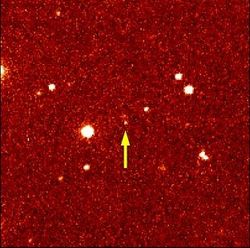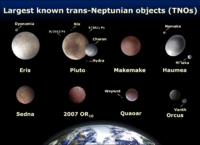Sedna
From CreationWiki, the encyclopedia of creation science
Jump to navigationJump to search
| Sedna |
 NASA diagram shows the presumed distance of the Oort cloud compared to the solar system planets, the Kuiper belt, and the orbit of Sedna. |
| Sedna | |
|---|---|

| |
| Date of discovery | Date of discovery::November 14, 2003 |
| Name of discoverer | Discoverer::Michael E. Brown, C. Trujillo, D. Rabinowitz |
| Orbital characteristics | |
| Celestial class | Member of::Trans-Neptunian object |
| Primary | Primary::Sun |
| Perihelion | Periapsis::76.361 AU |
| Aphelion | Apoapsis::937 AU |
| Semi-major axis | Semi-major axis::518,57 AU |
| Orbital eccentricity | Orbital eccentricity::0.8527 |
| Physical characteristics | |
| Color | Color::#FFFFFF |
Sedna or 90377 Sedna is a trans-Neptunian object discovered in 2003, which lies about three times farther from the Sun than Neptune. Many astronomers consider it a dwarf planet.[1][2][3]
References
- ↑ Barucci, et al. (2010). "(90377) Sedna: Investigation of surface compositional variation". The Astronomical Journal 140: 6. http://iopscience.iop.org/1538-3881/140/6/2095/.
- ↑ Rabinowitz, Schaefer, Tourtellotte, 2011. "SMARTS Studies of the Composition and Structure of Dwarf Planets". Bulletin of the American Astronomical Society, Vol. 43
- ↑ Malhotra, 2010. "On the Importance of a Few Dwarf Planets". Bulletin of the American Astronomical Society, Vol. 41

